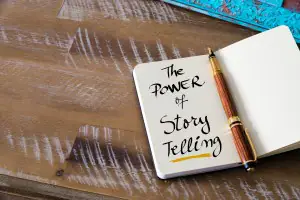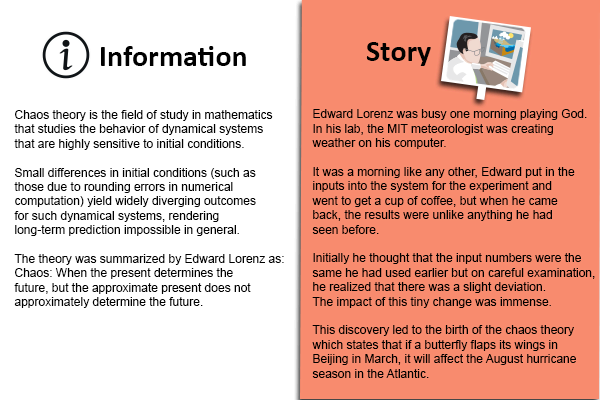
One day a nervous professor was standing in front of utterly uninterested class wondering how to start her first lecture. Standing in front of the class where everyone was checking their phones, barely glancing at her, she began by saying, “Let me tell you a story.” Suddenly everyone’s head snapped up and all eyes were on her: she had their attention.
Everyone loves stories. From the time we learnt to communicate, stories have been the chosen medium to pass on information and knowledge. Even in our daily lives, we all turn into storytellers; around water coolers, during our conversations with friends and family, we narrate our everyday events as stories.
Let’s explore why we should use stories in e-learning and if stories really do help us learn better.
Stories Are Attention-Grabbing
The reaction of the brain while engaging with stories is very different to reading or listening to information.
Paul Zak, an American neuroeconomist, has extensively researched the effects of storytelling on the human brain. In a study, he showed participants a video of a father and his young, cancer-ridden son. He then drew the blood samples from the participants before and after watching the video. The research found that two chemicals, oxytocin and cortisol, are released in the blood of the participants who watched the story. Cortisol is the “attention” chemical; it helps you to focus your attention.
Paul Zak mentions in an article that, “Scientists liken attention to a spotlight. We are only able to shine it on a narrow area. If that area seems less interesting than some other area, our attention wanders.”
Stories manage to “hook” you and retain your attention long enough for you to get involved in the story.
Stories Engage More Parts of the Brain
When you read a story, your imagination is in the driver’s seat. The brain readily supplies you with the complete picture of what is being said in a story.
For example, if I tell you a story about a Medical Representative, who is waiting nervously in a hallway of a busy sub-urban clinic, anxious that he is about to make his first call. The visual and auditory sections of your brain have already created a snapshot of this bustling place. Now if we add that he sat clutching a steaming cup of coffee, the olfactory sensory areas of the brain would evoke the smell of the coffee. Then if the story continued saying that when the person heard his name being called out, he jolted, spilling the coffee all over himself, the motor and sensory areas of the brain would light up, as you imagine the movement of the person and hot coffee spilling.
This shows that stories use more parts of the brain and give you a richer brain experience. Since you are enjoying the stories, you understand the content more deeply and this helps you learn and remember it for a longer time.
Stories Engage Empathy for Teaching
When you listen to or read a story, you get drawn into the action and connect with the characters in the story.
In the same study that Paul Zak found cortisol in the bloodstream of participants who watched a narrative video, the research also found that Oxytocin was present. Oxytocin is the “empathy chemical”. It makes you emotionally connect with the story and “feel” what the characters are feeling. So if you were watching Harry Potter, your heart rate will increase and your palms will sweat as you watch Harry confront Voldermort.
This immersion into a story is explained by psychologists Melanie C. Green and Timothy C. Brock in their theory of narrative transportation. The theory proposes that when we listen to stories we are ‘transported’ into its world. Even though you know you are watching or reading fiction, your brain stimulates the emotion you imagine the character must be feeling. You experience the incident without actually going through it yourself.
Stories Are Remembered Longer
In a study, researchers at Emory University found that stories caused neural changes in the brain that remained for several days after reading the story.
This illustrates the power of the story and why we remember them longer. So if your sales training include stories of actual incidents and anecdotes of what worked and what didn’t, it would be more impactful than learning “sales techniques” in a course.
Stories Add Meaning and Context
Unlike a string of facts or a large chunk of information where the reader has to construct the meaning and the internal connections, stories present us with information in a coherent form.
Stories bring information within a context and make it more real and memorable. They transform the abstract ideas into concrete, relatable examples.
“Through story, students can take data and facts that might seem to be disjointed pieces of information and tie them all together in one picture.” (Simmons, 2007; Green 2004).
Here is an example illustrating the effectiveness of “storyfying” information.

Source acknowledgments:
Chaos theory. (2016, June 21). In Wikipedia, The Free Encyclopedia. Retrieved 04:37, June 22, 2016, from
Thus we see that stories affect us deeply; they engage us at an emotional and cerebral level. Stories are tools that can be leveraged to make learning more powerful and engaging.
The young professor, who used a story to get the classes’ attention, used the power of the story to make learning more memorable.
To quote from an old proverb:
“Tell me a fact and I’ll learn. Tell me the truth and I’ll believe. But tell me a story and it will live in my heart forever.”






